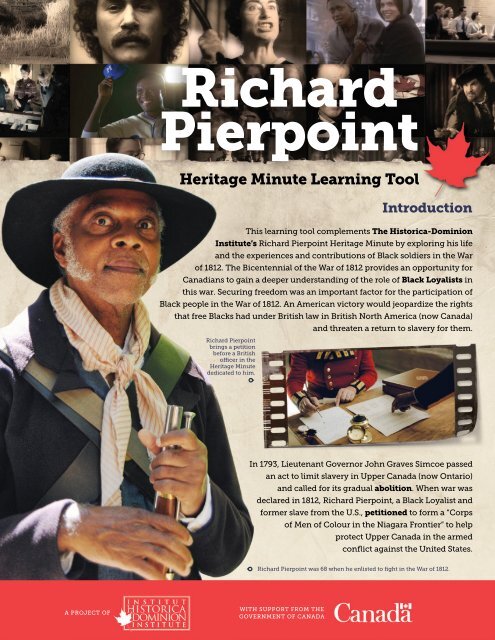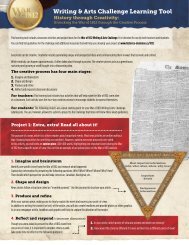Richard Pierpoint - Historica
Richard Pierpoint - Historica
Richard Pierpoint - Historica
You also want an ePaper? Increase the reach of your titles
YUMPU automatically turns print PDFs into web optimized ePapers that Google loves.
<strong>Richard</strong><br />
<strong>Pierpoint</strong><br />
Heritage Minute Learning Tool<br />
This learning tool complements The <strong>Historica</strong>-Dominion<br />
Institute’s <strong>Richard</strong> <strong>Pierpoint</strong> Heritage Minute by exploring his life<br />
and the experiences and contributions of Black soldiers in the War<br />
of 1812. The Bicentennial of the War of 1812 provides an opportunity for<br />
Canadians to gain a deeper understanding of the role of Black Loyalists in<br />
this war. Securing freedom was an important factor for the participation of<br />
Black people in the War of 1812. An American victory would jeopardize the rights<br />
that free Blacks had under British law in British North America (now Canada)<br />
<strong>Richard</strong> <strong>Pierpoint</strong><br />
brings a petition<br />
before a British<br />
officer in the<br />
Heritage Minute<br />
dedicated to him.<br />
Introduction<br />
and threaten a return to slavery for them.<br />
In 1793, Lieutenant Governor John Graves Simcoe passed<br />
an act to limit slavery in Upper Canada (now Ontario)<br />
and called for its gradual abolition. When war was<br />
declared in 1812, <strong>Richard</strong> <strong>Pierpoint</strong>, a Black Loyalist and<br />
former slave from the U.S., petitioned to form a “Corps<br />
of Men of Colour in the Niagara Frontier” to help<br />
protect Upper Canada in the armed<br />
conflict against the United States.<br />
<strong>Richard</strong> <strong>Pierpoint</strong> was 68 when he enlisted to fight in the War of 1812.<br />
A PROJECT OF<br />
WITH SUPPORT FROM THE<br />
GOVERNMENT OF CANADA
Black<br />
Loyalists<br />
Enslaved African American men enlisted in the British Army to fight in the American Revolution (1775-1783) in exchange for<br />
their freedom. After the British were defeated, approximately 3,000 Black Loyalists came to live in British North America. A<br />
few dozen Black Loyalists settled across the southern portion of Upper Canada, while thousands settled in what are now the<br />
maritime provinces of Nova Scotia and New Brunswick.<br />
The names of Black settlers who went to eastern Canada<br />
from New York City are recorded in the “Book of Negroes,”<br />
a 150-page military ledger.<br />
DID YOU KNOW? Canadian author Lawrence Hill’s award-winning novel<br />
The Book of Negroes (2007) was inspired by the experiences of Black Loyalists<br />
whose names were recorded in the historical document of the same name.<br />
Artist<br />
applies<br />
makeup<br />
to actor<br />
before<br />
his scene.<br />
Exercise<br />
Conduct research to locate areas of settlement by Black Loyalists, and identify them on a map<br />
of modern-day Canada. Start your research using these resources:<br />
Black Loyalists: Our History, Our People blackloyalist.com/canadiandigitalcollection<br />
Canada in the Making: Pioneers and Immigrants (1775-1812)<br />
canadiana.ca/citm/themes/pioneers/pioneers4_e.html<br />
The Freedom Seekers: Blacks in Early Canada by Daniel G. Hill (Toronto: Irwin Publishing Inc., 1981)<br />
For a history of slavery and early Black settlement in Canada, search these websites:<br />
blackhistorycanada.ca and civilization.ca<br />
For tips on how to analyze a primary source such as the “Book of Negroes,”<br />
visit: <strong>Historica</strong>-Dominion.ca/1812<br />
Who was<br />
<strong>Richard</strong> <strong>Pierpoint</strong>?<br />
Actors playing Black Loyalists on the way to<br />
battle in the <strong>Richard</strong> <strong>Pierpoint</strong> Heritage Minute.<br />
The man we know as <strong>Richard</strong> <strong>Pierpoint</strong> was kidnapped in Bondu (now part of Senegal,<br />
West Africa) in 1760 and sold into slavery in the United States when he was 16 years<br />
old. The name <strong>Richard</strong> was given to him and his last name was likely his owner’s.<br />
His birth name is not known. During the American Revolution, <strong>Pierpoint</strong> enlisted with<br />
Butler’s Rangers. His military service came with a promise of freedom for enslaved<br />
Blacks who fought in support of the British Crown.<br />
When the war ended, <strong>Pierpoint</strong>, along with other Loyalists, both Black and White,<br />
migrated to Upper Canada. For his military service, he received a 200-acre land grant<br />
(free land from the government) in Grantham, a township in the Niagara region. In<br />
1794, <strong>Richard</strong> was one of 19 free African men who unsuccessfully requested land plots<br />
beside one another in order to form a close community of mutual help and support.<br />
<strong>Richard</strong> <strong>Pierpoint</strong> and the War of 1812<br />
At the age of 68, <strong>Pierpoint</strong> presented the government with the signatures of Black men he had recruited to<br />
form a militia company to defend Upper Canada during the War of 1812. The idea was initially turned down,<br />
but soon an all-Black militia, commanded by a white officer named Captain Robert Runchey, was started in<br />
Niagara. <strong>Pierpoint</strong> and his men were joined by soldiers from across Upper Canada, forming the new unit. They<br />
were known as “Runchey’s Company of Coloured Men,” and later the Coloured Corps.<br />
The Coloured Corps fought in several battles including at Queenston Heights on October 13, 1812, where they<br />
were among the first reinforcements to arrive and help take the Heights back from the Americans. After 1812,<br />
the Corps was assigned to rebuild destroyed forts throughout the Niagara region and to construct the new<br />
Fort Mississauga. The stories of the approximately 40 soldiers who made up the Coloured Corps are not well<br />
known. They can be identified by name – though often only by their adopted names – but their personal<br />
stories and contributions have been lost or forgotten.<br />
2<br />
<strong>Richard</strong> <strong>Pierpoint</strong> - Soldier by Meredith Blackmore, 2012.<br />
Courtesy of the Wellington County Museum and Archives.
The War Veteran’s Role in his Community<br />
In 1821, an elderly <strong>Richard</strong> <strong>Pierpoint</strong> petitioned the Government of Upper Canada to be given passage to Senegal so that he might live out<br />
the rest of his life in his homeland. The petition was rejected; and he was awarded another land grant, this time in Garafraxa Township<br />
(near present-day Fergus, Ontario).<br />
In Garafraxa, he cleared his land and played an important role as an elder in the area’s growing Black community. By 1826, the now<br />
82-year-old <strong>Pierpoint</strong> had built a cabin and fulfilled other settlement requirements, with community assistance, to permanently own the<br />
land. He died around 1838, and the Black community he helped create eventually dispersed.<br />
Perspectives<br />
An examination of the diverse perspectives of a historical event or issue is important in developing a better understanding<br />
of a particular time and place in history.<br />
<br />
1.<br />
2.<br />
3.<br />
Activity<br />
Primary documents, like the “Book of Negroes” and personal journals, are items created by people during the time period. Few<br />
documents exist from the perspective of Black Loyalists. Write a fictional journal entry, in the first person, as a Black Loyalist<br />
telling the story about a part of your life.<br />
Using the PBS source below, Black Sailors and Soldiers in the War of 1812, record some information about the life of a Black<br />
soldier fighting on the American side. Describe any similarities and differences with the experiences of Black militiamen who<br />
fought for British North America. pbs.org/wned/war-of-1812/essays/black-soldiers-and-sailors-war-of-1812<br />
<strong>Richard</strong> <strong>Pierpoint</strong> gained his new name at some point after his departure from Africa, likely from his slave owner. Write a journal<br />
entry from his perspective on how he would have felt about his new name.<br />
Definitions<br />
Black Loyalist<br />
Enslaved Africans who obtained freedom<br />
in return for fighting for the British<br />
during the American Revolution.<br />
Abolition<br />
The act of ending the practice<br />
of slavery.<br />
Petition<br />
A written request made to government<br />
supported by the signatures of<br />
numerous people.<br />
Middle Passage<br />
The voyage taken by captive Africans<br />
across the Atlantic Ocean from the west<br />
coast of Africa to the Americas.<br />
For a list of primary and secondary<br />
resources, visit:<br />
<strong>Historica</strong>-Dominion.ca/1812<br />
Oral Traditions<br />
According to oral history in the Black Canadian community, <strong>Richard</strong> <strong>Pierpoint</strong> was a skilled storyteller. He travelled around Upper Canada with his friend<br />
“Deaf Moses” before and after the War of 1812, memorizing the stories of Black Loyalists they met along the way. It is believed that <strong>Pierpoint</strong> associated a<br />
person’s story with a unique pebble. He could re-tell the stories by pulling a pebble from his pouch and remembering each story. In the <strong>Richard</strong> <strong>Pierpoint</strong><br />
Heritage Minute, <strong>Pierpoint</strong> receives a pebble after his enslavement and later passes that pebble to his fellow soldier, Deaf Moses. Watch the Minute again;<br />
can you see the pebble changing hands?<br />
In West African cultures, storytellers, referred to by the French word griot, memorize, preserve and share the histories of families and communities.<br />
<strong>Pierpoint</strong> may have talked about his lost family in Bondu, the horrific Middle Passage to the Americas, the experiences<br />
of enslaved Africans in the United States, or the life of an 18th and early 19th century soldier.<br />
Activity<br />
1. Recount a special event or memory about your family through a story.<br />
Share it with your class.<br />
2. Do you remember stories from your family’s history that you were told<br />
from your parents’ or grandparents’ memories?<br />
What value do you think this kind of storytelling has?<br />
3. If not a stone, what object would you use to symbolize the<br />
important stories you wanted to remember and why?<br />
<strong>Richard</strong> <strong>Pierpoint</strong> - Settler by Meredith Blackmore, 2012.<br />
Courtesy of the Wellington County Museum and Archives.<br />
3
Black Canadians in<br />
Military Service<br />
People of African descent have a long history of military service in Canada.<br />
They have enlisted in the military to protect British North American and<br />
Canadian interests in every major conflict since the War of 1812. Many served<br />
in racially segregated units until the Second World War when the Canadian<br />
military became fully integrated. Research the involvement of Black Canadians<br />
in these conflicts or one of these all-Black companies:<br />
• War of 1812<br />
• Upper Canada Rebellions of 1837<br />
• The Victoria Pioneer Rifle Corps (African Rifles), 1861-1865<br />
• First World War (No. 2 Construction Battalion)<br />
• Second World War<br />
Discussion Questions<br />
1. How was their fight in each conflict also a battle against racism?<br />
2. Why do you think Black Canadians continued to serve in the<br />
Canadian military even though they encountered obstacles to do so?<br />
3. Compare the experiences of Black soldiers in the different conflicts.<br />
What was similar? What was different?<br />
To hear the stories of Black Second World War veterans such<br />
as Leonard Braithwaite, visit The Memory Project Archive at<br />
TheMemoryProject.com.<br />
Media Literacy<br />
Media literacy is the ability to critically analyze the messages that are<br />
communicated through mass communications like television, radio and<br />
the Internet. Given the power and influence of the media today, it is more<br />
important than ever to understand how to view it critically. Watch the<br />
<strong>Richard</strong> <strong>Pierpoint</strong> Heritage Minute and then consider the questions below.<br />
Citizenship<br />
and Immigration<br />
People of African descent in Upper Canada held different social statuses before, during and<br />
after the War of 1812. There were enslaved Africans in Upper Canada who were considered<br />
to be personal property and had no legal rights even after the war. Due to their race, even<br />
free Blacks had only limited rights. Incoming refugees from American slavery continued<br />
to migrate to Upper Canada after the War of 1812, launching the start of the Underground<br />
Railroad movement. Under Lieutenant Governor John Graves Simcoe’s 1793 Act to Limit<br />
Slavery, no new slaves could be brought into Upper Canada. It wasn’t until 1819, however,<br />
that Attorney General John Beverly Robinson declared that any Black person living in Upper<br />
Canada was automatically free.<br />
Despite their difference in status, early Black settlers worked to create communities while<br />
also battling the racial discrimination that threatened their rights and freedoms.<br />
Activity<br />
1. Watch the <strong>Richard</strong> <strong>Pierpoint</strong> Heritage Minute, and then analyze <strong>Pierpoint</strong>’s motivation to<br />
join the war. How does it affirm his citizenship and reinforce his place in his community?<br />
2. Identify some Black Canadians who were active citizens in their communities. Describe<br />
their occupations, roles, responsibilities, obstacles and accomplishments.<br />
BEFORE<br />
Heritage Minute<br />
footage shot<br />
at Westfield<br />
Heritage Village,<br />
Ontario.<br />
1. Identify your favourite section of the Minute. Explain to your class<br />
why this scene had the strongest impact on you.<br />
2. How does the music enhance the mood of the <strong>Richard</strong> <strong>Pierpoint</strong><br />
Heritage Minute?<br />
3. Take a look at the “before and after” images on the right of this page.<br />
When we seek to reconstruct the past using digital technology for mediums<br />
such as television, what factors do we need to consider to make sure they<br />
are historically accurate?<br />
Making of the Minute<br />
For an activity on “How to Make Your Own Heritage Minute,”<br />
to watch the <strong>Richard</strong> <strong>Pierpoint</strong> Heritage Minute, and to view<br />
behind-the-scenes extras on the making of the Minute,<br />
visit <strong>Historica</strong>-Dominion.ca/1812.<br />
AFTER<br />
CGI effects turn<br />
these images<br />
into Bondu,<br />
Senegal.<br />
4




